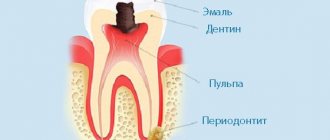Tonsillitis
One of the most common causes of pain in the root of the tongue is inflammation of the palatine tonsils, a special tissue in the throat that performs the body’s protective function against inhaled pathogens. Most often, such a complication occurs with tonsillitis, also called tonsillitis, which is an inflammation caused by staphylococci or streptococci (less commonly, other microorganisms such as fungi or viruses).
In addition to the fact that the base of the tongue is very painful for a sick person, tonsillitis is characterized by the following symptoms :
- pain when swallowing;
- general intoxication;
- swelling of the tonsils;
- sore throat;
- hyperemia;
- temperature rise to fibril levels;
- enlarged lymph nodes.
The root of the tongue often hurts when the tonsils are inflamed.
The classification of angina has seven main types: catarrhal, lacunar, follicular, fibrinous, herpetic, phlegmonous and ulcerative-membranous. Treatment of tonsillitis involves, first of all, maintaining bed rest and providing the patient with a gentle, but at the same time fortified diet, as well as plenty of warm drinks.
Depending on the nature of the occurrence of sore throat, the means of drug therapy vary, which may include antibiotics, antifungal drugs, antimicrobial drugs, antiseptics and analgesics, which can relieve pain in the tongue and throat.
Important! Additionally, it is recommended to gargle with natural herbal decoctions and infusions based on chamomile, sage and eucalyptus.
Other causes of sore throat and ear pain
In addition to sore throat and ear pain, all of the above inflammatory pathologies have one more common symptom: increased body temperature. However, there are other reasons for which pain symptoms occur, and they are not associated with inflammation. Therefore, there is no elevated temperature with them or occurs only when the process is neglected.
| Initiating factor | What is it characterized and manifested by? |
| Traumatic injuries to the mucous membrane | Pain can occur due to a burn (thermal or chemical), ingress of a foreign body, or mechanical impacts. |
| Neoplasms of benign and malignant etiology | Benign and malignant neoplasms of the larynx are a fairly rare phenomenon that can make it difficult to eat and cause pain. Requires seeking professional medical help. |
Inflammation of the lingual tonsil
A rather rare complication of tonsillitis, which manifests itself against a background of weakened immunity, is angioma - inflammation of the lingual tonsil, which is located at the root of the tongue. Despite its rarity, this disease is complex and painful, and lack of treatment threatens the patient not only with pain at the root of the tongue, but also with serious complications such as rheumatism, polyarthritis, sepsis and myocarditis.
The symptoms characteristic of angioma are similar to those of ordinary sore throat, but are noticeably more severe and have a number of specific differences:
- temperature increase;
- pain when swallowing;
- enlarged lymph nodes;
- swelling of the tongue;
- impaired immunity;
- probable appearance of purulent plaque.
Sore throat often causes pain in the root of the tongue.
The patient complains of severe pain in the deep parts of the throat, which also intensifies with active movements of the tongue (especially when moving it forward). Swelling causes difficulty breathing, swallowing and speech, and worsened inflammation leads to severe migraines.
Treatment of angioma depends on the degree of neglect of the disease, and in the early stages coincides with the principles of treatment of acute sore throat: taking vitamins, drinking warm liquids, inhalation, rinsing with soda solutions or decoctions. In more serious cases, ice is applied to the throat, alternating with warm compresses, and antibiotics and painkillers are also prescribed.
If the diagnosed symptoms include an abscess, the doctor may need to open it to relieve the patient's condition.
Treatment of glossitis
Professional dentists do not recommend treating glossitis in adults and children at home - this can lead to a rapid worsening of the situation and the emergence of severe complications.
As a rule, doctors use conservative drug treatment with the correction of the underlying diseases that provoke glossitis of the tongue - photos can be seen on the Internet. To reduce pain, doctors recommend eating soft foods that do not cause mechanical irritation to the affected areas of the tongue.
In severe cases, the patient may require hospital treatment in a clinic and even surgery. However, such cases are extremely rare!
Inflammation of the tongue
Another likely cause of pain at the root of the tongue is inflammation of the tongue, called glossitis. It is an infectious lesion of the tissues of the tongue, caused in most cases by staphylococcus or streptococcus bacteria, but sometimes the causative agent is fungi (usually the Candida type) or bacteria responsible for diseases of the gastrointestinal tract, lungs and other organs.
Glossitis tends to differ quite greatly from each other in terms of clinical manifestations, but the general signs of the disease are as follows:
- swelling of the tongue;
- change in the condition of its mucous membrane;
- the appearance of plaque on the tongue or on the entire oral mucosa;
- formation of spots, defects, ulcers or erosions;
- difficulty speaking and swallowing;
- low temperature;
- general weakness.
The tongue may hurt due to inflammation of its tissues.
Some types of glossitis cause inflammation on the side of the tongue - on the right or left, others affect its upper plane, but there is also a glossitis that directly affects the base of the tongue. This variety is called diamond-shaped because of the characteristic thickening of the epithelial layer near the root of the tongue, resembling a diamond (about its back third).
The surface of this thickening can be either smooth or lumpy, having a bluish-red tint. Often this glossitis is chronic in nature, since it may not cause discomfort to the patient for a long time, and it is quite difficult to see it by accident due to its location. However, as glossitis progresses, the tongue may begin to hurt, as well as cause a burning or itching sensation, which becomes a reason to consult a doctor.
The causes of rhomboid glossitis are the activation of pathogenic infections caused by fungi or bacteria, but bad habits such as smoking and drinking alcohol play a significant role in accelerating the disease.
The cause may be chronic tonsillitis.
Note! Treatment of glossitis should begin with giving up these habits, as well as with complete professional sanitation of the oral cavity to eliminate provoking factors. Further therapy may include the use of antibiotics, antiseptics and antifungal drugs.
Characteristic symptoms of glossitis of the tongue
Symptoms are varied, as a rule, they depend on the type of disease: viral, bacterial, candida glossitis - photos can be found on the Internet or in consultation with a specialized specialist. Glossitis in adults and children develops in the same way and has no obvious symptomatic differences.
In the initial stages of development, a person experiences discomfort in the mouth, a burning sensation, and a sensation of a foreign body. After some time, the color of the mucous membrane of the tongue changes - it acquires a rich red, grayish or burgundy color.
Gradually increasing swelling provokes excessive salivation, taste sensations disappear, and in some cases taste is distorted. Eating food becomes difficult and quite painful, so patients, when eating, try not to use their tongue when chewing, which leads to crumbs and whole pieces of food falling out of the mouth.
Most patients do not know how to treat glossitis on the tongue in adults, some of them do not go to the doctor - this provokes the appearance of abscesses and phlegmon, as well as the transition of the acute form of the disease to a chronic one, with all the ensuing consequences.
Peritonsillar abscess
Peri-almond abscess, or phlegmonous tonsillitis, is most often a complication of the usual form of acute tonsillitis. The condition develops due to the spread of an infectious lesion into the tissue near the tonsils. The pathological condition in 60% of cases is unilateral, however, the formation can be identified from different sides, that is, from each side. For example, with pain in the root region of the tongue on the left, we can say that the abscess arose there.
In addition to the fact that the patient has pain in the root part of the tongue on the left or right, and the unpleasant symptoms increase during the process of swallowing, other symptoms :
- migraines and less intense headaches;
- increase in body temperature up to critical;
- swelling in the tongue area;
- Difficulties in maintaining dialogue up to the loss of voice;
- trismus (spasm of the masticatory muscles).
One of the reasons is a spasm of the chewing muscles.
Also, in some cases, they complain of the appearance of bad breath and the fact that the patient’s head may be slightly tilted in the direction that was affected.
To ensure effective treatment of peri-almond abscess, antibiotic components are prescribed. Most often they refer to penicillins or cephalosporins. Amoxicillin has traditionally been the first choice drug.
Causes of chronic pain in the throat and ear
Pain in the throat and ear, without or with fever, is one of the most common complaints of patients visiting an otolaryngologist. On average, about 15% of patients seek professional help. As already mentioned, most often the pain occurs on one side; There are also cases when it covers both sides.
The reasons for this phenomenon lie in pathological processes affecting several anatomical structures, but not necessarily. There are often cases when the pain radiates to the ear when the throat is affected. The features of human anatomy are such that the ear, throat, mouth and nose form a communicating system, interconnected by channels.
When inflammation develops in any of the organs, the process spreads through these channels, affecting other structures of the system - the organs of hearing and the pharynx - which provokes pain in the throat and ear. The patient may complain of a sore throat radiating to the ear - or, conversely, the appearance of pain in the organ of hearing and spreading to the throat. It also happens that the patient cannot accurately determine the source of pain.
Symptoms in the form of pain are characteristic of a wide range of pathological conditions, which you can learn about by reading our tables presented in the following sections.
Injuries and burns on the root of the tongue
Not only inflammatory diseases can provoke the formation of unpleasant symptoms at the root of the tongue. Such pain can be provoked by injury or burn of the mucous surface of this organ. The reasons for this, in turn, may be the use of spicy foods, as well as very hot drinks or various dishes.
Other reasons that the root of the tongue hurts may be:
- inhalation of harmful fumes (for example, in a chemical production plant);
- consumption of caustic liquids - acid or alkali, which can be either accidental or intentional;
- serious facial injuries, blows to the chin area or directly under the jaw (in an accident, a fall from a height, and even in a fight);
- damage to the affected area of the tongue due to dental or surgical devices during therapy.
In the case where the damage is minor, it heals without specialized medical intervention. The microflora of the mouth, as well as the special composition of saliva, has a positive effect on this. It is possible to speed up healing by rinsing with antiseptic compounds. This could be mixing water with baking soda or sea salt.
In case of significant damage, when inflammation of the root of the tongue threatens complications, the help of a surgeon is recommended. If incorrectly installed dentures and implants are a factor in the development of injury, you should make an appointment with an orthopedic dentist.
Diagnostics
To make a diagnosis, you should consult a dentist. If the cause is not of a dental nature, then you need to undergo an examination to identify the true causes of the disease. The following methods are used for diagnosis:
- collection . At the first visit, the patient outlines complaints, existing allergic reactions or injuries, chronic diseases, etc.
- Visual inspection. The doctor assesses the patient's condition based on the existing signs. If it is possible to eliminate the problem immediately, surgical manipulations are carried out. For example, removing a bone from the tongue.
- A clinical blood test to determine the presence of an inflammatory process in the body.
When a disease is detected, the doctor determines treatment tactics.











